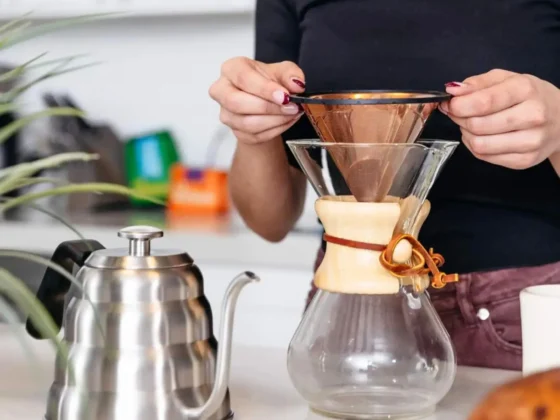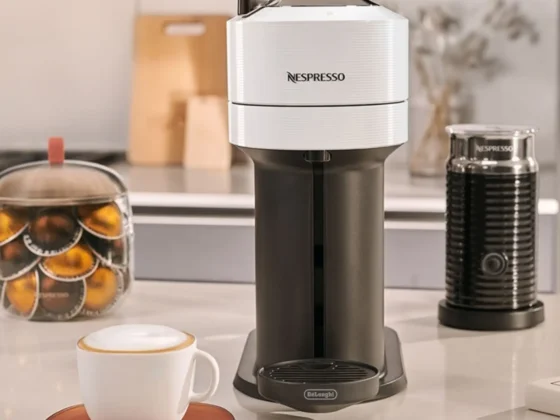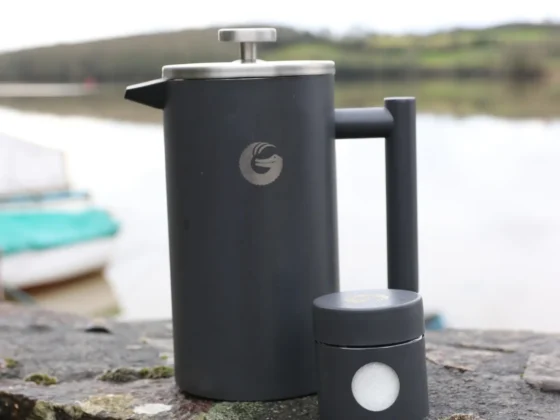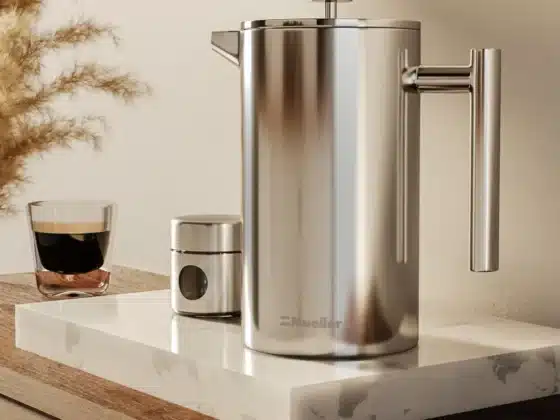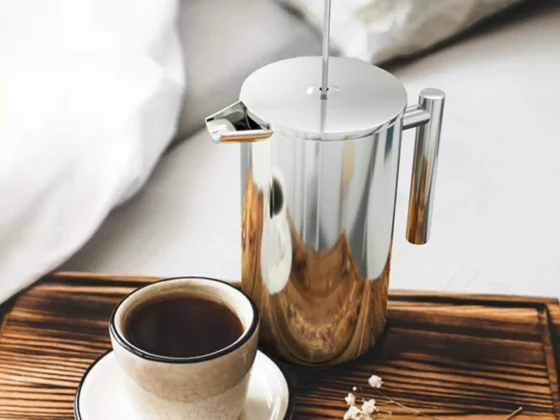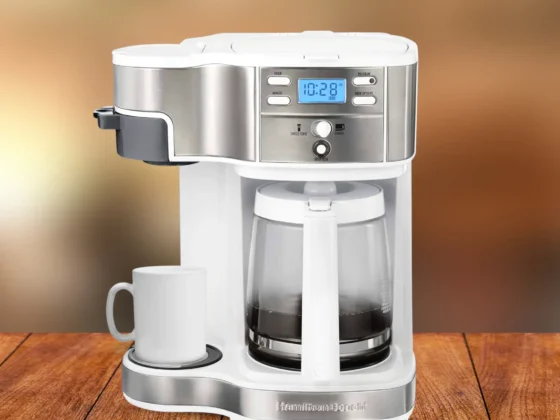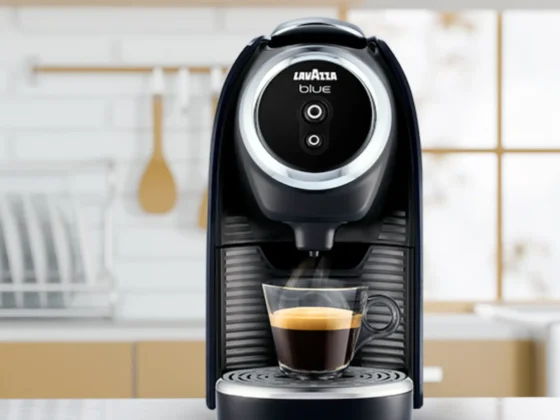In the search for the best coffee experience, enthusiasts often weigh the Hario V60 vs Kalita Wave in pour-over coffee brewing. This article compares these two popular methods, exploring their features, brewing techniques, and flavors to guide you through the world of coffee making.
Need a break from reading? Listen to the article by clicking below.
- Introduction & Key Differences
- https://app.mysoundwise.com/tracks/17023360396082659e.mp3
- Design and Build
- https://app.mysoundwise.com/tracks/17023360690169973e.mp3
- Hario V60 vs Kalita Wave: Brewing Process
- https://app.mysoundwise.com/tracks/17023360995532554e.mp3
- Consistency & Flavor
- https://app.mysoundwise.com/tracks/17023361317027839e.mp3
- User Experience
- https://app.mysoundwise.com/tracks/17023361631956099e.mp3
- Kalita Wave vs Hario V60: Pricing Analysis
- https://app.mysoundwise.com/tracks/17023362022149744e.mp3
- History of the Hario V60 and Kalita Wave
- https://app.mysoundwise.com/tracks/17023362358539504e.mp3
- Conclusion & FAQs
- https://app.mysoundwise.com/tracks/17023362719933684e.mp3
Kalita Wave vs Hario V60: Key Differences
- Diverse Brewing Approaches: The Hario V60 suits experimental enthusiasts, offering dynamic flavor exploration, while the Kalita Wave emphasizes consistency for a reliably balanced cup.
- User-Friendly vs. Customizable: The V60’s hands-on experience caters to pour-over aficionados, whereas the Kalita provides a more accessible, user-friendly option with a shallower learning curve.
- Versatility vs. Consistency: The V60 allows diverse flavor experimentation, appealing to the adventurous, while the Kalita excels in producing consistently balanced cups, suitable for a set-and-forget approach.
- Flavor Characteristics: The V60 accentuates clarity and brightness, ideal for acidity and complexity, whereas the Kalita strikes a balance, offering clarity, complexity, and a smoother finish.
- Budget and Material Choices: Hario V60 and Kalita Wave choices involve pricing, material preferences, and accessories, allowing users to tailor their decisions based on budget, material aesthetics, and brewing accessories.
Design and Build
From the conical elegance of the V60, fostering precise water flow, to the flat-bottomed sophistication of the Kalita Wave, ensuring a controlled and consistent extraction, each element contributes to a unique pour-over experience.
Hario V60 Design
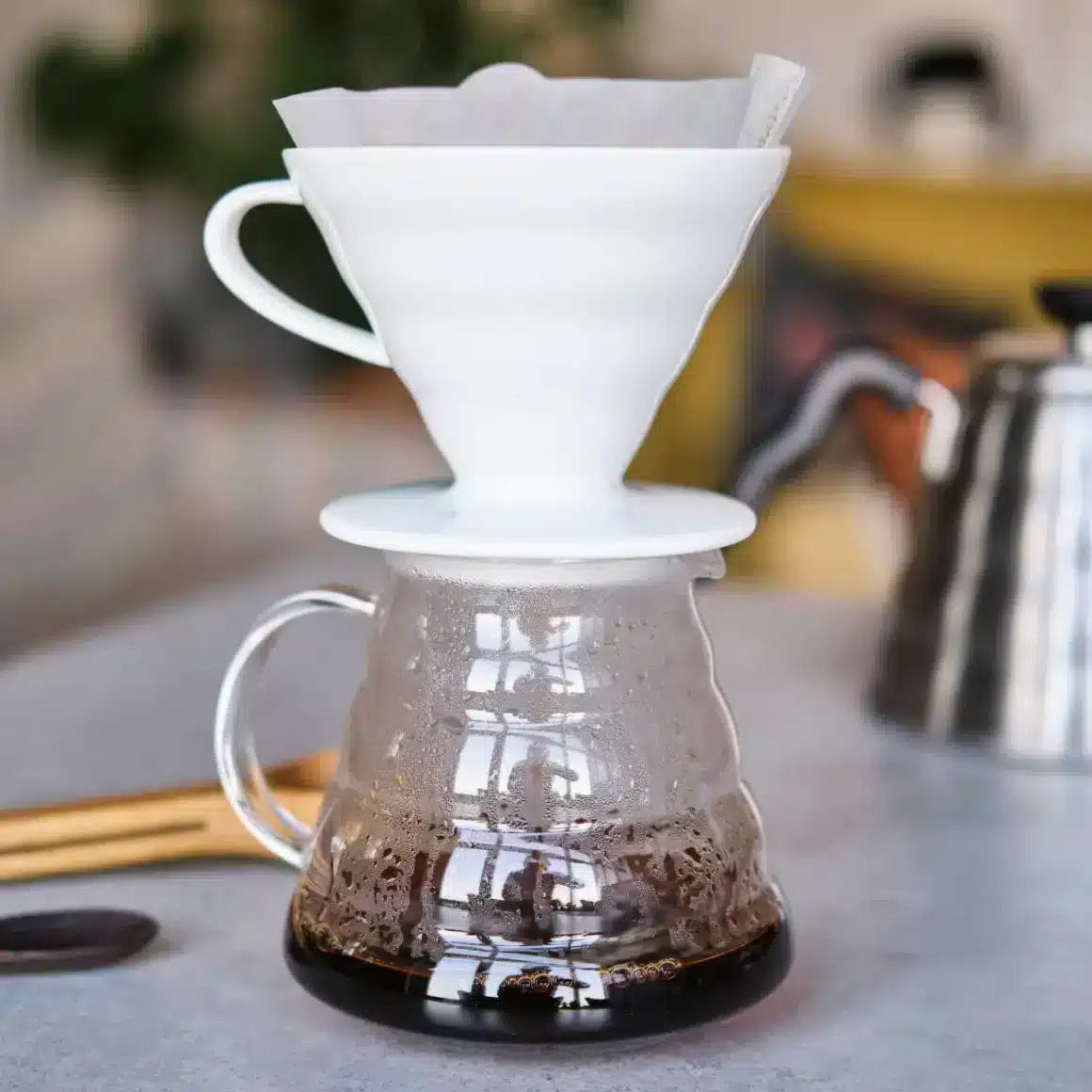
| Preview | Product | |
|---|---|---|

|
Hario V60 Ceramic Coffee Dripper, Size 02, White | See on Amazon |

|
Hario V60 Coffee Pour Over Kit Bundle Set – Comes with Ceramic Dripper, Range Server Glass Pot,… | See on Amazon |
The Hario V60 is a pour-over coffee dripper known for its simple yet effective design, which allows for a controlled and customizable coffee brewing process. Here are key aspects of the design and build of the Hario V60:
- Cone Shape: The V60 is characterized by its conical shape, with a large opening at the top and a pointed bottom. This design promotes water flow and extraction efficiency.
- Spiral Ridges: The interior of the V60 features spiral ridges or grooves that run along the sides of the cone. These ridges serve to create a space between the filter and the dripper, allowing for optimal water circulation.
- Single Large Hole: At the bottom of the cone, there is a single, large hole. This is where the brewed coffee flows through into the server or cup below.
- Material Options: Hario V60s are available in various materials, including ceramic, glass, plastic, and metal. Each material may offer different benefits such as heat retention, durability, and aesthetic appeal.
- Size Options: The V60 comes in different sizes denoted by numbers 01, 02, and 03. The larger the number, the greater the brewing capacity. The choice of size allows users to match the dripper to their specific brewing needs.
- Openings: The large opening at the top facilitates the easy pouring of water and coffee grounds, and it also allows users to observe the brewing process.
The design and build of the Hario V60 pour over reflect a balance between simplicity and functionality. Its popularity among coffee enthusiasts is attributed to its aesthetic appeal, the control it offers over brewing variables, and the ability to produce a clean and nuanced cup of coffee.
Kalita Wave Design
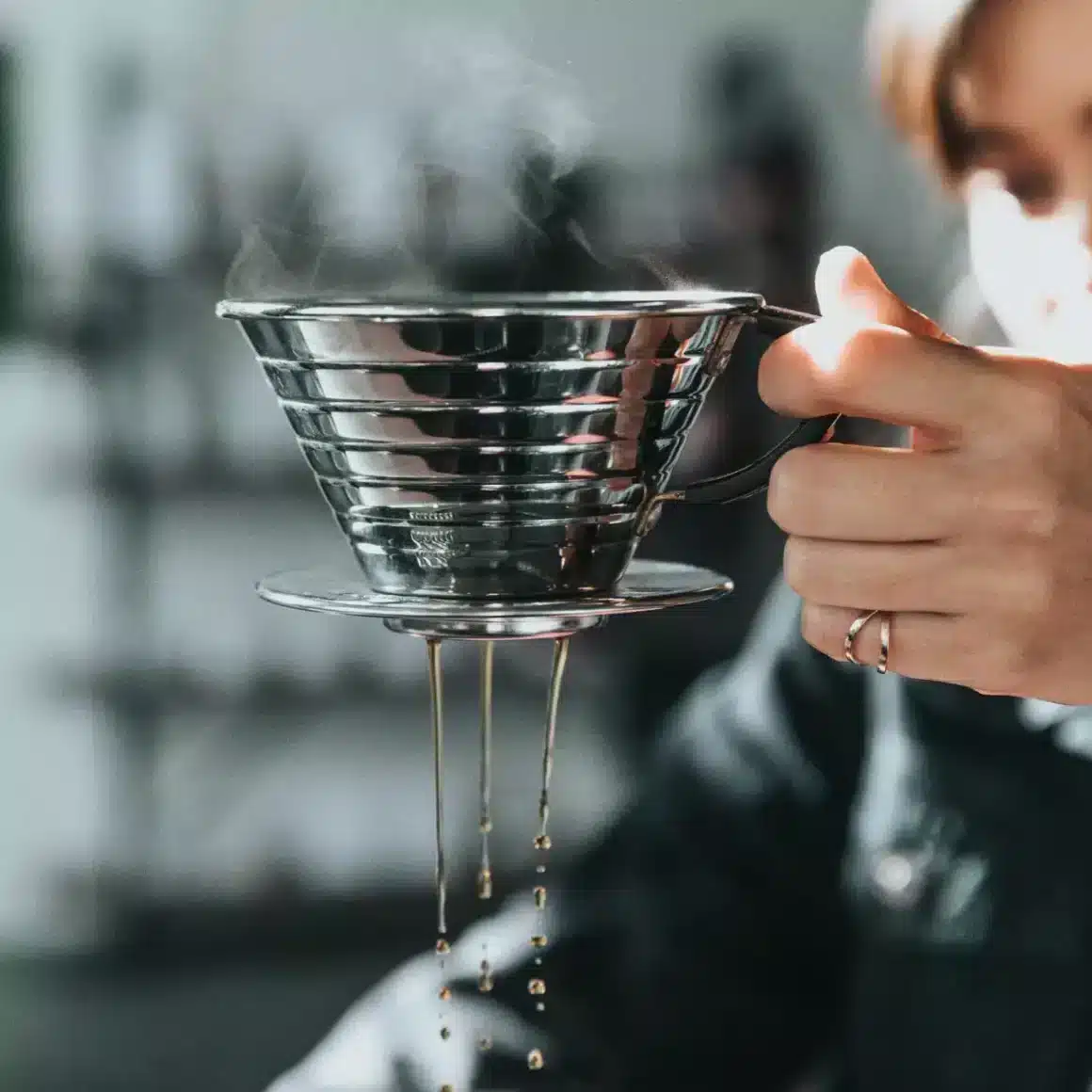
| Preview | Product | |
|---|---|---|

|
Kalita Wave Pour Over Coffee Dripper, Size 185, Makes 16-26oz, Single Cup Maker, Heat-Resistant… | See on Amazon |

|
Kalita Wave 185 Drippers | See on Amazon |
The Kalita Wave is another popular pour-over coffee dripper, known for its unique design that aims to provide a more controlled and consistent extraction. Here are key features of the design of the Kalita Wave:
- Flat-Bottomed Shape: The Kalita brewer has a flat-bottomed design, distinguishing it from the cone-shaped drippers of the Hario V60. The flat bed with three small drainage holes promotes a more uniform extraction.
- Wave Filters: The Kalita Wave uses proprietary filters that are wave-shaped with three layers of paper. The unique design of these filters helps to regulate the flow of water and maintain even contact with the coffee grounds, contributing to a balanced extraction.
- Three Drainage Holes: At the bottom of the flat bed, there are three small drainage holes. These holes are strategically placed to control the flow of water and ensure that it passes through the coffee grounds evenly.
- Ribs and Grooves: The interior of the Kalita Wave has ribs and grooves that help with air circulation and prevent the filter from sticking to the dripper, allowing for better water flow.
- Material Options: Similar to the Hario V60, the Kalita Wave is available in various materials, including ceramic, glass, stainless steel, and copper. Each material may offer different heat retention properties and aesthetic characteristics.
- Size Options: The Kalita comes in different sizes, such as 155 and 185, with variations in capacity. The size choice allows users to match the dripper to their specific requirements.
The Kalita Wave pour over’s design is focused on achieving a balanced and even extraction, and its popularity is attributed to its ability to produce a clean, consistent cup of coffee. The specific design elements, such as the flat bottom and wave filters, contribute to its unique brewing characteristics.
Hario V60 vs Kalita Wave: Brewing Process
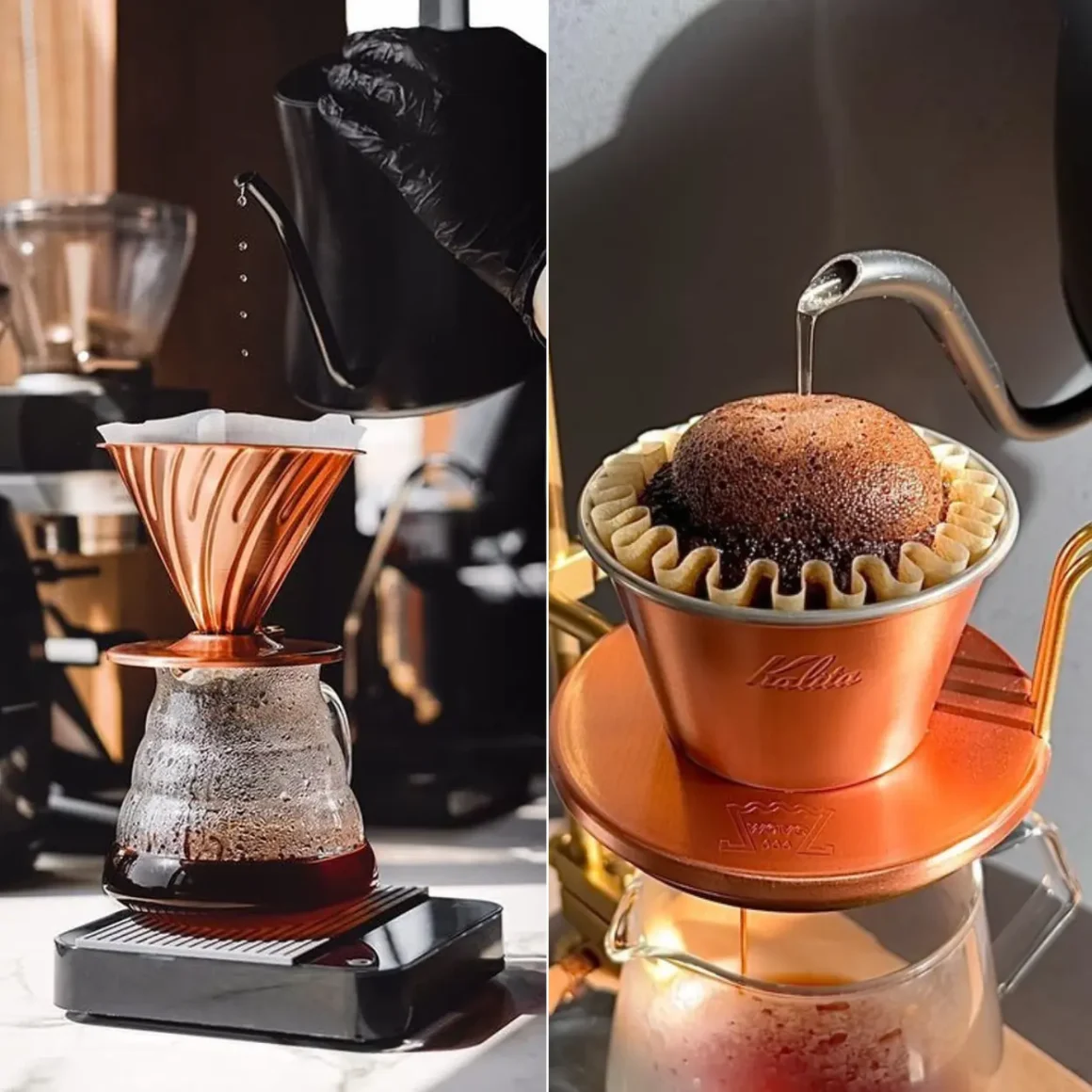
Whether one leans towards the artistry of precision or the pursuit of consistency, the brewing methods of the Hario V60 and Kalita Wave cater to diverse tastes and preferences in the world of pour-over coffee.
Hario V60
The brewing style with the V60 involves a manual pour-over method that allows for a high degree of control. Here’s a general guide on the steps to follow:
- Equipment and Ingredients: Gather your Hario V60 dripper, a V60 paper filter, freshly ground coffee beans, a pouring kettle, a scale, and hot water.
- Preheating: Place the V60 paper filter in the dripper and rinse it with hot water to remove any paper taste and preheat the brewer and server.
- Coffee Dose: Weigh and grind your coffee beans to a medium-coarse consistency. The recommended coffee-to-water ratio is typically around 1:15 to 1:17.
- Bloom: Add the ground coffee to the pre-wet filter in the V60. Pour a small amount of hot water (about twice the weight of the coffee) over the coffee grounds, ensuring all grounds are saturated. Allow it to bloom for around 30 seconds.
- Pouring Technique: Begin the main pour by adding water in a controlled, circular motion. Pour in stages, allowing the water to soak into the coffee grounds before adding more. The goal is an even saturation.
- Maintain Water Level: Keep the water level in the V60 from getting too high to prevent over-extraction. Control the brewing time by adjusting the pouring rate.
- Total Brewing Time: The total brewing time usually ranges from 2 to 4 minutes, depending on factors like grind size and coffee freshness. Adjust your grind and pouring technique to achieve the desired extraction time.
- Serve: Once the water has passed through the coffee grounds and the dripping slows down, your pour-over coffee is ready to be served.
The Hario V60 dripper’s brewing style offers a hands-on and customizable approach, making it a favorite among coffee enthusiasts who enjoy the process of fine-tuning their brew to achieve the desired flavor profile.
Kalita Wave
The brewing style with the Kalita Wave also involves a manual pour-over method, and it’s known for its focus on achieving a more consistent extraction. Here’s a general guide on the brewing style with the Kalita:
- Equipment and Ingredients: Gather your Kalita Wave dripper, a Kalita Wave paper filter, freshly ground coffee beans, a pouring kettle, a scale, and hot water.
- Preheat the Dripper: Place the Kalita Wave paper filter in the dripper and rinse it with hot water to remove any paper taste and preheat the brewer and server.
- Coffee Dose: Weigh and grind your coffee beans to a medium-coarse consistency. The recommended coffee-to-water ratio is typically around 1:15 to 1:17.
- Bloom: Add the ground coffee to the pre-wet filter in the Kalita Wave. Pour some hot water (about twice the weight of the coffee) over the coffee grounds, ensuring all grounds are saturated. Allow it to bloom for 30 seconds.
- Pouring Technique: Add water in a controlled, circular motion. You can pour directly into the center without worrying too much about pouring in circles. Pour in stages, allowing the water to soak into the coffee grounds.
- Maintain Water Level: Keep an eye on the water level in the Kalita Wave to prevent over-extraction. Adjust the brewing time by controlling the pouring rate.
- Total Brewing Time: The total brewing time usually ranges from 3 to 4 minutes. Adjust your grind size and pouring technique to achieve the desired extraction time.
- Serve: When the dripping slows down as all the water passes through the coffee grounds, your pour-over coffee should be ready.
The Kalita Wave dripper’s brewing style is appreciated for its emphasis on consistency and control. It provides a balance between user-friendly brewing and the ability to fine-tune variables to achieve a well-balanced cup of coffee.
Hario V60 vs Kalita Wave: Consistency & Flavor
Before diving into the details of Consistency & Flavor, it’s important to recognize that both the Hario V60 and Kalita Wave, while excelling in different aspects, share the common goal of delivering an exceptional pour-over experience.
Hario V60
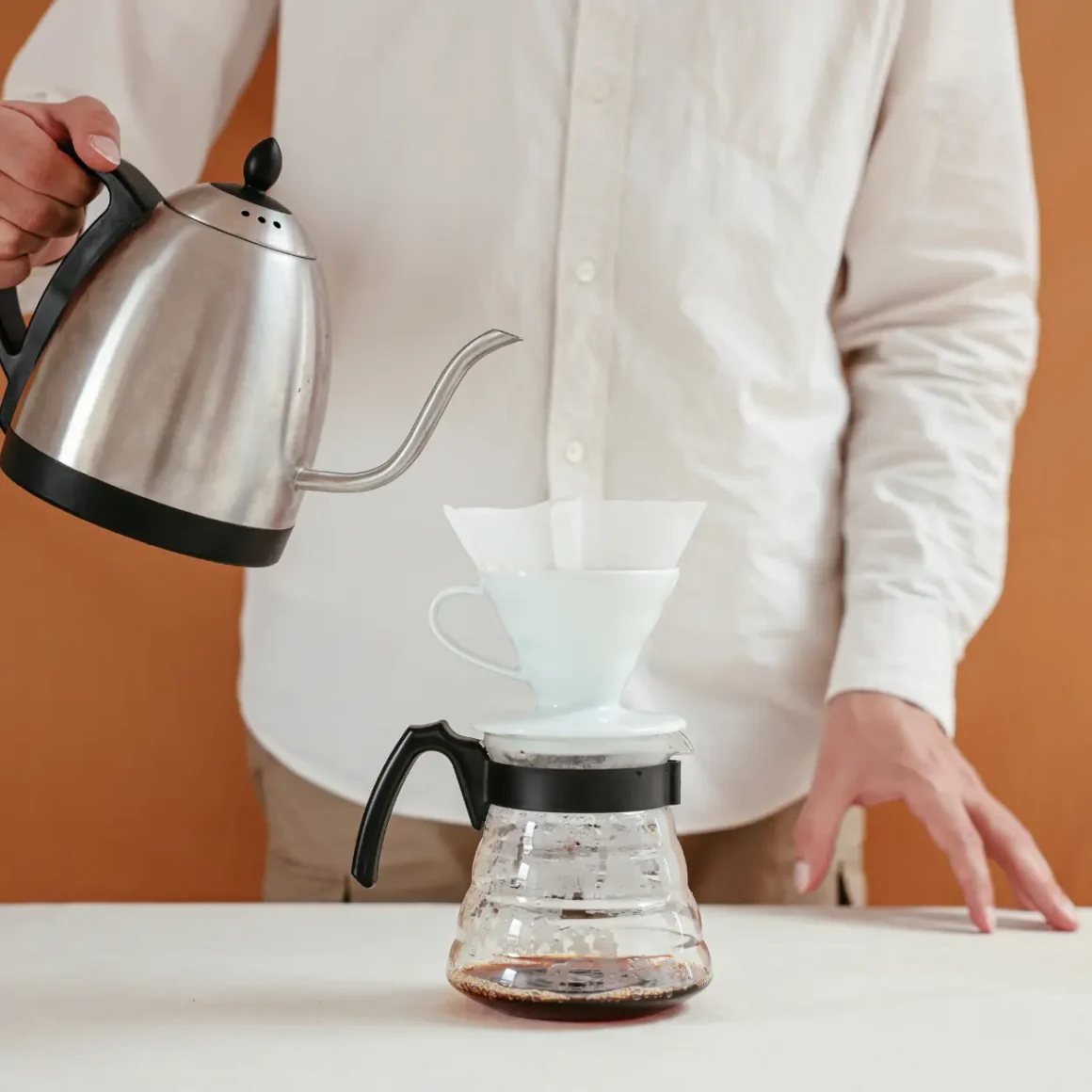
The Hario V60 is known for its versatility and the ability to produce a dynamic range of flavors depending on the brewing parameters chosen by the user. Here are some considerations regarding the consistency and taste associated with the V60 brewer:
- Variable Extraction: The conical shape and single large hole at the bottom of the V60 can lead to a more variable extraction compared to flat-bottomed drippers. This variability allows users to experiment with different brewing variables, resulting in a cup that can highlight different flavor notes.
- Dynamic Flavor Profile: The V60 is favored by those who enjoy a dynamic and nuanced flavor profile. The ability to control variables such as grind size, pouring technique, and water temperature allows users to emphasize specific characteristics of the coffee.
- Clarity of Flavor: Due to its cone shape and the single large hole, the V60 can produce a cup with clarity and brightness. It’s known for bringing out the acidity and complexity of certain coffees.
- Highlighting Origin Characteristics: The V60 is well-suited for single-origin coffees, as it can highlight the unique characteristics of different coffee beans.
- Customization: Users have the flexibility to experiment and customize their brew to suit their taste preferences. This makes the V60 a favorite among coffee enthusiasts who enjoy the art and science of coffee brewing.
The Hario V60 offers a brewing experience that is known for its dynamic and variable nature. It provides a canvas for users to explore the characteristics of different coffees and refine their brewing techniques. While achieving consistency may require some practice and experimentation, the potential for a wide range of flavors makes the V60 a popular choice for those who appreciate the craft of pour-over coffee brewing.
Kalita Wave
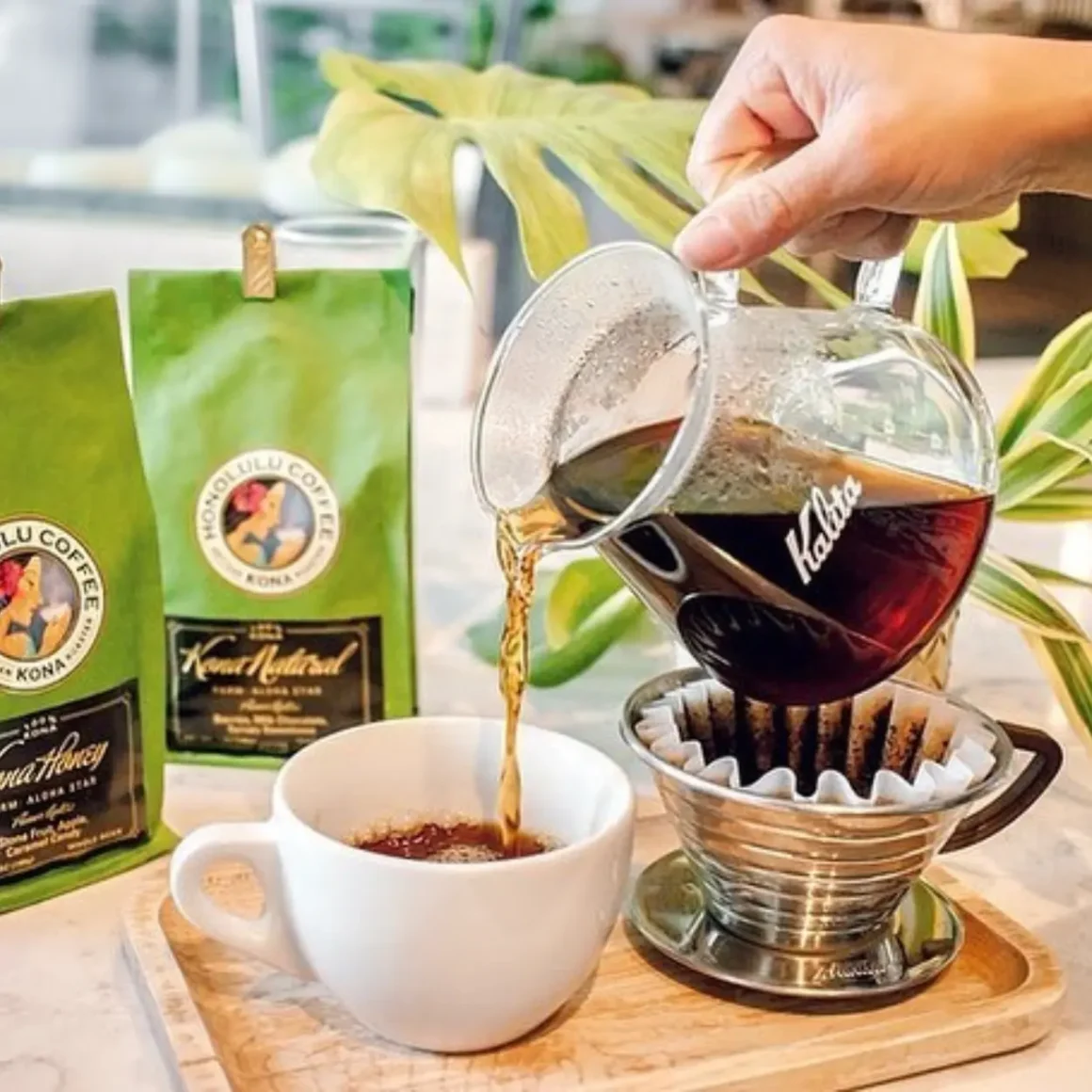
Here are some considerations regarding the consistency and taste associated with the Kalita Wave:
- Consistent Extraction: The design of the Kalita Wave aims to provide a consistent extraction, resulting in a cup that showcases the balanced flavors of the coffee without extreme highs or lows.
- Balanced Flavor Profile: The Wave is known for producing a well-balanced cup with a good representation of acidity, sweetness, and body. It tends to accentuate the sweetness of the coffee without overly emphasizing acidity or bitterness.
- Clarity and Complexity: While promoting consistency, the Wave also allows for a certain level of clarity and complexity in the flavor profile. Users can still discern subtle notes and characteristics of the coffee beans.
- Suitable for Different Coffees: The Kalita Wave is versatile and can work well with a variety of coffee beans. It’s appreciated for its ability to produce a clean and clear cup that respects the inherent qualities of different origins.
- Smooth Finish: The controlled flow rate and even extraction contribute to a smooth and pleasant finish in the cup.
The focus on consistency makes the Kalita Wave a popular choice for those who appreciate a reliable and repeatable pour-over coffee experience. Its design, with a flat-bottomed shape and specific drainage holes, contributes to a controlled brewing process that is accessible to both beginners and experienced coffee enthusiasts.
Hario V60 and Kalita Wave: User Experience
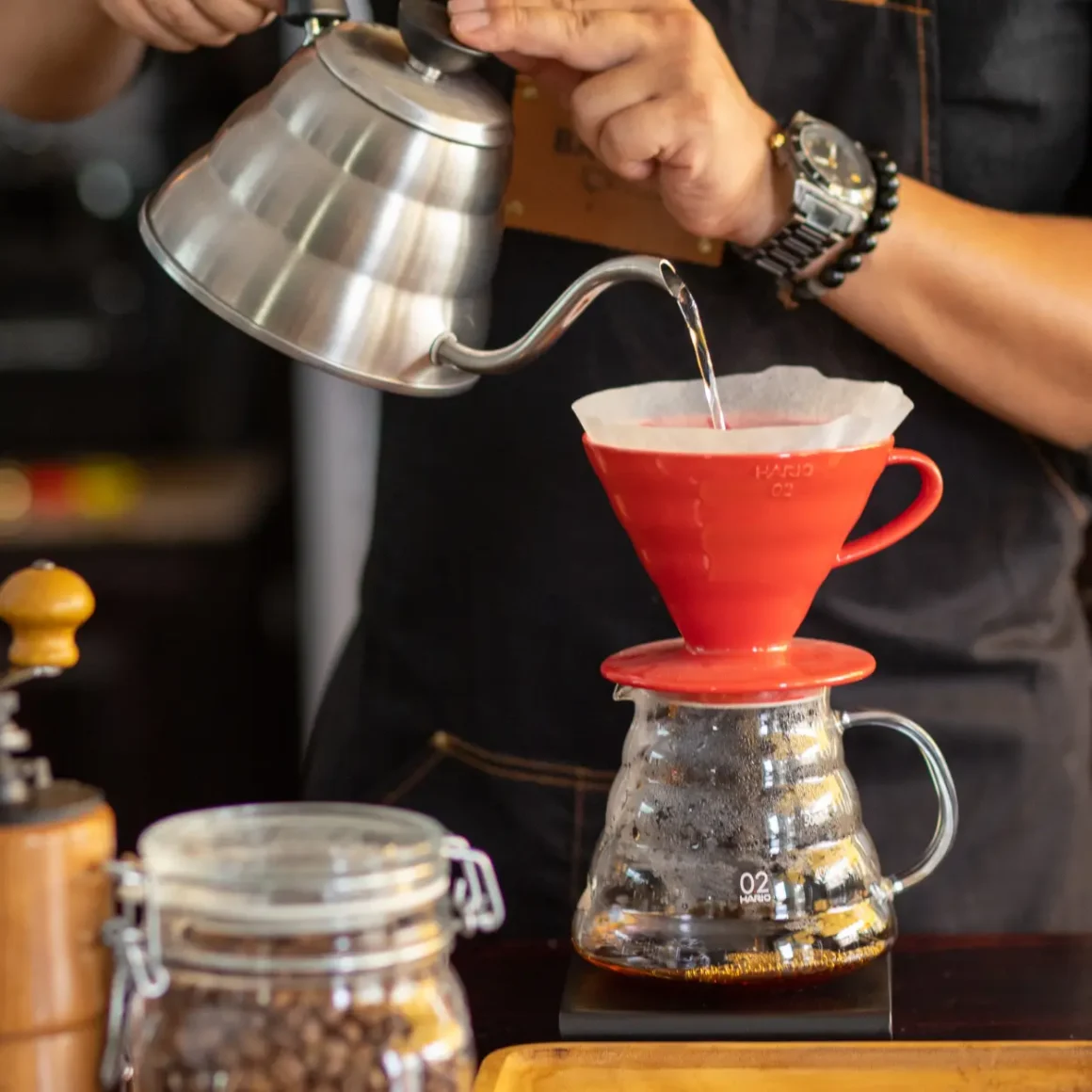
Looking into the aspect of User Experience, it’s crucial to acknowledge that both the Hario V60 and Kalita Wave cater to different preferences on the spectrum of pour-over brewing.
Hario V60
The user experience with the Hario V60 can be both rewarding and challenging, depending on your preferences and familiarity with pour-over brewing. Here’s a breakdown of the user experience and the learning curve associated with the V60:
- Versatility: The V60 allows users to experiment with various brewing parameters, such as grind size, water temperature, pouring technique, and coffee-to-water ratio. This versatility makes it a favorite among coffee enthusiasts who enjoy the hands-on aspect of brewing.
- Pouring Technique: Achieving a consistent and well-extracted cup often involves mastering the pouring technique. Controlling the flow rate and ensuring even saturation of the coffee grounds can take some practice.
- Grind Size Adjustment: Experimenting with grind size is a key aspect of using the V60. Finding the right grind size for your taste preferences and adjusting it based on different coffee beans can be part of the learning process.
- Brewing Variables: Understanding how variables such as water temperature, coffee-to-water ratio, and pouring patterns impact the final cup is essential. The learning curve involves experimenting with these variables to achieve the desired flavor profile.
- Consistency: Achieving consistency with the Hario V60 can take time and practice. Users often refine their technique over multiple brews to produce reliable and repeatable results.
- Experience-Driven: The learning curve with the Hario V60 is experience-driven. Users often find that the more they use it, the better they become at controlling the variables and achieving their preferred cup of coffee.
The Hario V60 offers a rich and customizable user experience, but it comes with a learning curve. The process of refining your technique and finding the optimal brewing parameters can be both challenging and rewarding. Many coffee enthusiasts appreciate the journey of mastering the V60 and enjoy the opportunity to explore the full potential of their coffee beans through the method.
Kalita Wave
The Kalita Wave offers a user-friendly and consistent brewing experience, making it accessible to both beginners and experienced coffee enthusiasts. Here’s an overview of the user experience and learning curve associated with the Kalita Wave:
- Ease of Use: The Kalita Wave is often considered more forgiving for beginners. The flat bed and controlled flow rate make it accessible to those who may be new to pour-over brewing. Users can achieve good results with less emphasis on precise pouring techniques.
- Pouring Technique: While the Kalita Wave is forgiving in terms of pouring technique, users can still experiment with pouring patterns and speeds to influence the extraction. Learning to pour in a controlled and consistent manner can enhance the overall experience.
- Grind Size Adjustment: Similar to other pour-over methods, adjusting grind size is an important aspect of using the Kalita Wave. Users may need to experiment to find the optimal grind that suits their taste and brewing parameters.
- Filter Rinsing: Rinsing the paper filter thoroughly before brewing is a crucial step. It helps remove any paper taste and preheats the dripper for a more stable brewing temperature.
- Experience-Driven Learning: Similar to the Hario V60, the learning curve with the Kalita Wave is experience-driven. Users often find that as they brew more with the Kalita Wave, they gain a deeper understanding of its characteristics and how to optimize their brewing process.
The Kalita Wave provides a positive user experience with a balance between consistency and user-friendliness. While there’s a learning curve, it is generally less steep compared to some other pour-over methods, making it an excellent choice for those who value both ease of use and the ability to achieve a reliably great cup of coffee.
Kalita Wave vs Hario V60: Pricing Analysis
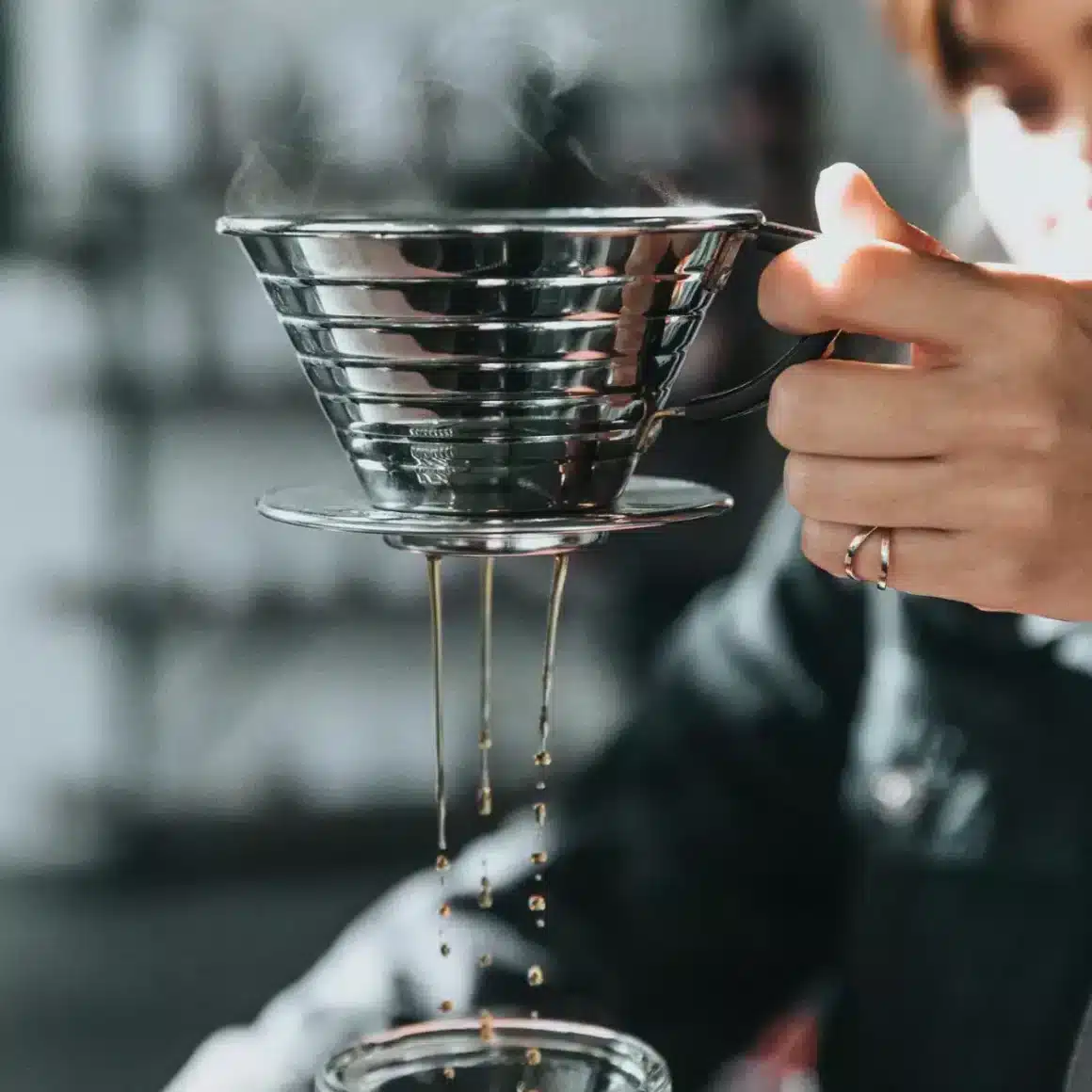
Now, let’s delve into the realm of Pricing Analysis, where the investment in your pour-over experience is as diverse as the brews themselves. Both the Hario V60 and Kalita Wave offer various materials and sizes, catering to different tastes and budgets.
Hario V60: Prices
When considering the Hario V60, it’s essential to factor in the material (plastic, glass, ceramic, or metal), size, and any additional accessories included in the purchase. Specialty coffee retailers, online marketplaces, and local kitchenware stores are common places to find Hario V60 drippers.
- Plastic Hario V60: This is often the most budget-friendly option. Prices typically range from $8 to $20.
- Glass Hario V60: The glass version tends to be mid-range in terms of pricing. Prices typically range from $15 to $30.
- Ceramic Hario V60: Ceramic versions are usually in the mid to higher price range. Prices can range from $25 to $35.
- Metal Hario V60: Metal versions, like the stainless-steel variant, are often on the higher end of the pricing spectrum. Prices can range from $30 to $45.
Prices may also vary based on the size of the Hario V60, with Size 01 being smaller and usually more affordable than Size 02 or Size 03. Additionally, bundle deals that include accessories like filters or servers can affect the overall price.
Kalita Wave Variants
The Kalita comes in two variants. The Kalita Wave 155 comes in a smaller size designed for single cups or smaller batches and is suitable for brewing around 10 to 16 grams of coffee. The Kalita Wave 185 on the other hand is much larger and suitable for brewing multiple cups or larger batches, accommodating a higher coffee dose between 20 and 30 grams.
- Kalita Wave 155: Prices for the Kalita Wave 155 vary based on the construction material. The glass variant is a more economical option, typically ranging between $20 and $25. In contrast, the stainless-steel version is priced in the range of $35 to $65, offering a durable and premium alternative.
- Kalita Wave 185: For the 185 variant, the glass model is priced around $25 to $30. In addition, the conventional stainless-steel option falls within the $35 to $60 range. When it comes to filters, a single pack of Kalita Wave 185 filters can be purchased for around $12 while value packs also come in bundles of two or more.
These variants cater to different preferences in terms of brewing capacity, material preference, and aesthetic appeal. The choice between 155 and 185 depends on the quantity of coffee you want to brew, while the material choice is often influenced by factors such as heat retention, durability, and personal choice.
History of the Hario V60 and Kalita Wave
The coffee industry is rich in innovation and history, especially when it comes to brewing equipment. Two names stand out in this regard: the Hario V60 and the Kalita Wave. Both have significantly influenced coffee brewing methods and culture, yet each has its unique story.
Hario V60
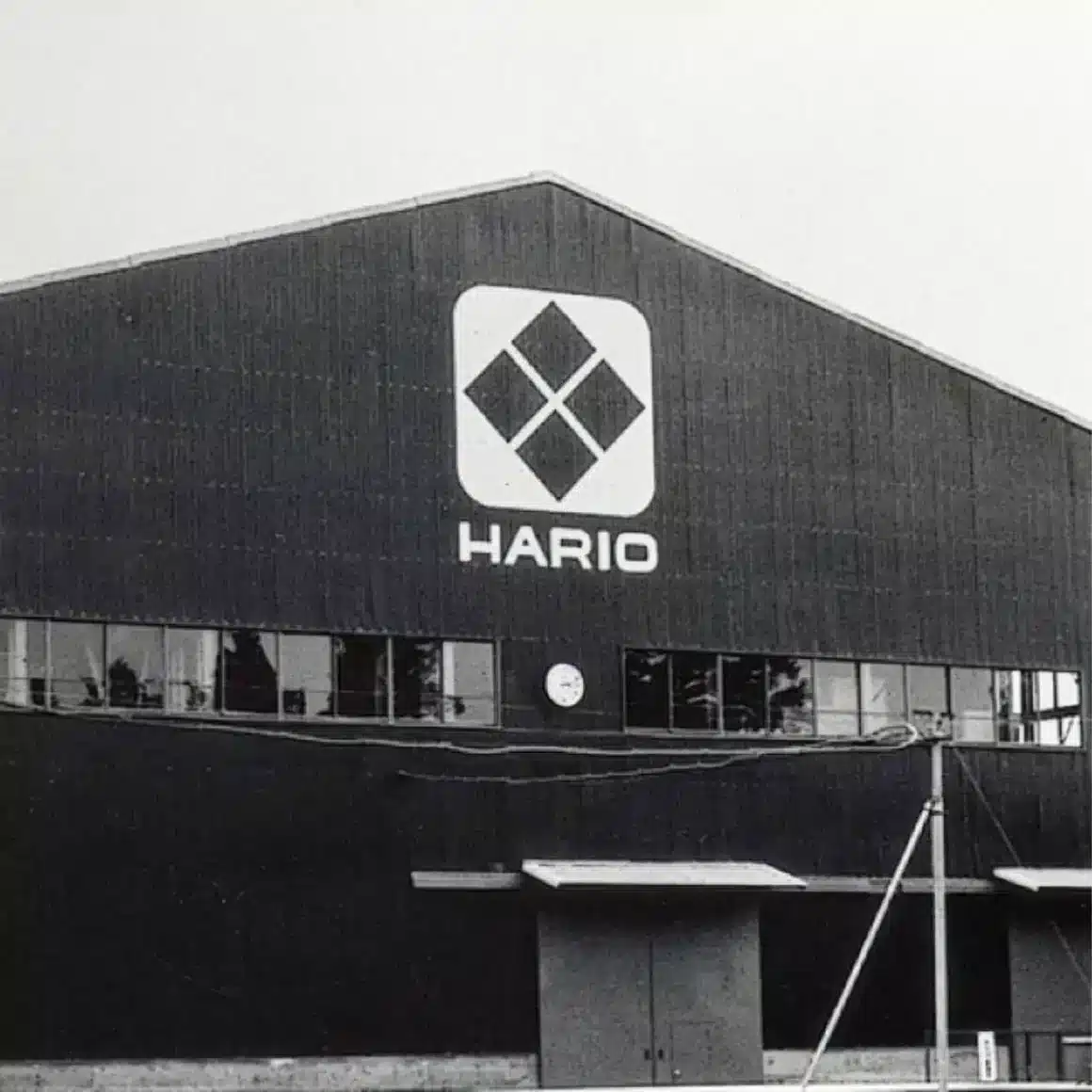
The Hario V60 coffee dripper owes much of its fame to the rich and intriguing history of the Hario company. Here’s a detailed timeline that encapsulates the pivotal moments and milestones in the evolution of the Hario V60:
- World Brewers Cup Recognition (2010): The Hario V60 catapulted to global fame following the 2010 World Brewers Cup in London. Its unique design and brewing capabilities were recognized and celebrated by coffee enthusiasts worldwide.
- Origins and Innovation: Originating in 1921 as a heat-resistant glass manufacturer in Japan, Hario has always prioritized innovation and design. This approach led to the development of several coffee-related innovations, including the Syphon, Slow Drip, and the V60.
- Design Evolution: Initially exploring the potential of parabolic-shaped drippers in the 1980s, Hario’s designers ultimately created the V60, a conical dripper that revolutionized the coffee brewing process.
- V60 Design Breakthrough (2004): After years of development, the V60 emerged with its distinctive spiral ribbing and conical shape, designed to replicate the flavor of cloth-filtered coffee. (1)
- Ongoing Innovation: Hario continues to innovate, planning to introduce a ceramic V60 in various colors, combining traditional craftsmanship with contemporary design.
Kalita Wave
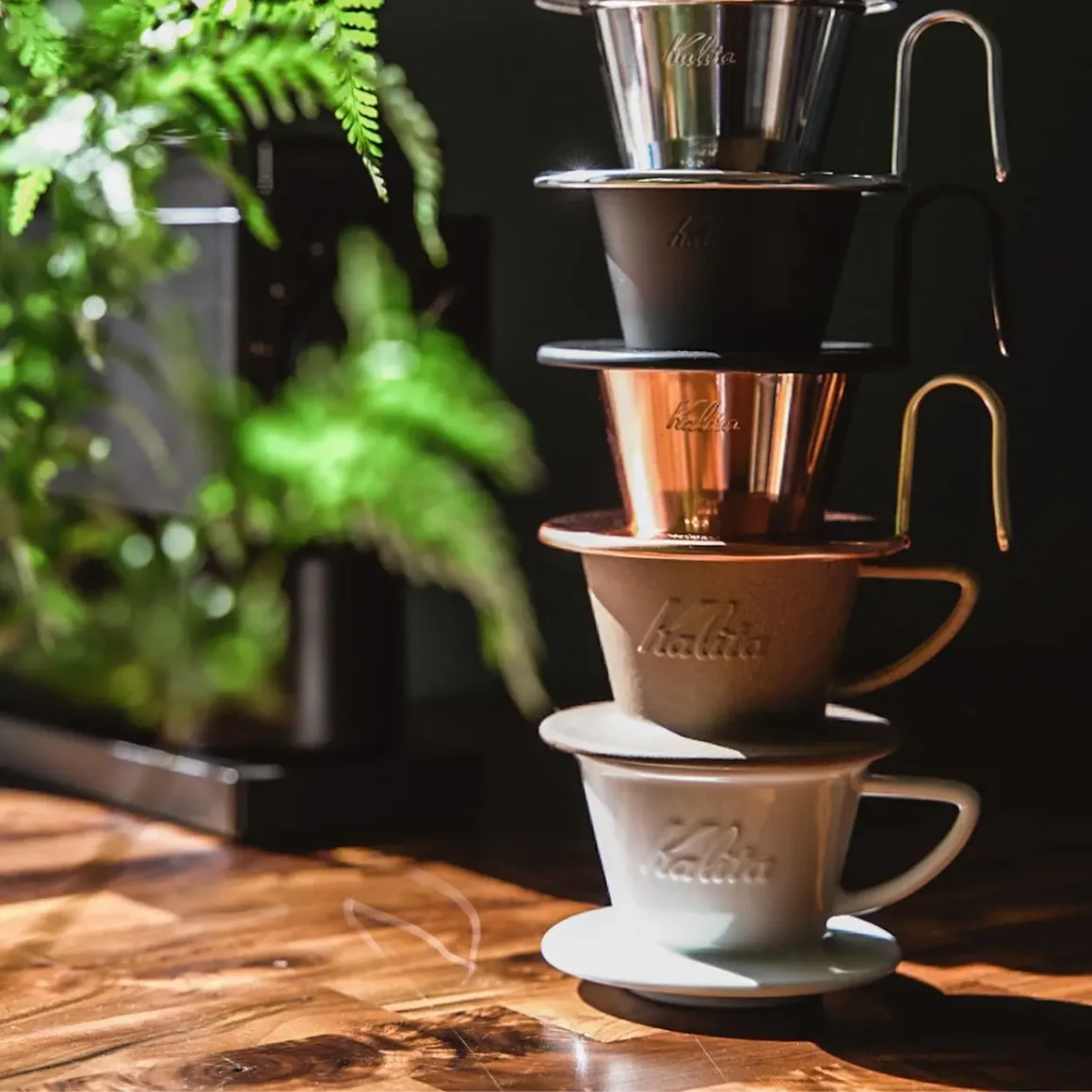
Kalita Wave has carved out a significant place in the coffee brewing world with its distinctive approach and designs that cater to both professional baristas and home enthusiasts.
- Establishment and Specialty (1958): Kalita has been a key player in the Japanese coffee scene since 1958, specializing in high-quality coffee brewing equipment. (2)
- Focus on Quality: Emphasizing the “Made in Japan” label, Kalita prides itself on precision, quality, and aesthetic elegance in its products, integrating traditional craftsmanship with modern design.
- Global Expansion with Espresso Parts (2016): In a strategic collaboration, Espresso Parts joined with Kalita Japan to enhance the global availability of Kalita products, particularly in the United States.
- Brand Evolution (2022): Espresso Parts and Kalita Japan introduced a new brand experience through KalitaUSA.com, expanding their reach and influence in the specialty coffee market.
- Espresso Parts Legacy: Since 1993, Espresso Parts has been a trusted supplier in the coffee industry, known for its commitment to quality and customer service, further bolstering the presence of Kalita products globally.
Both the Hario V60 and Kalita Wave represent the pinnacle of coffee brewing innovation and craftsmanship. Their histories are not just about the products themselves but also about how they have shaped the coffee culture and preferences of enthusiasts around the world.
Conclusion
In the long-standing debate about the Kalita wave vs V60, the choice between the two ultimately boils down to personal preferences and brewing priorities. Both pour-over coffee drippers have earned their places in the hearts of coffee enthusiasts, offering distinct characteristics that cater to different tastes and styles.
The Hario V60, with its conical shape and large single hole, provides a dynamic and versatile brewing experience. Its emphasis on user control allows for a wide range of flavor profiles, making it an ideal choice for those who enjoy experimenting with various brewing variables and appreciate the subtle notes in their coffee.
On the other hand, the Kalita Wave, characterized by its flat-bottomed design and three small drainage holes, excels in consistency and ease of use. It is often favored by those seeking a more forgiving brewing process while still delivering a well-balanced cup of coffee. The Kalita Wave’s focus on uniform extraction makes it a reliable choice for both beginners and experienced brewers.
FAQs
What type of filters should I use with the Hario V60?
When it comes to Hario V60 filters, the preference should be to use the white or natural brown ones, to achieve optimal results and minimize paper taste.
Which pour-over method produces the best coffee flavor?
The best coffee flavor from pour-over methods is subjective, as it depends on individual taste preferences; however, both the Hario V60 and Kalita Wave are renowned for producing high-quality coffee with distinct characteristics.
Are there any drawbacks to using the Kalita Wave?
Drawbacks to the Kalita Wave may include a potentially slower brew time and a need for precise pouring, which can be a consideration for some users.
Can I use the Hario V60 for cold brew coffee?
While the Hario V60 is not specifically designed for cold brew, it can be adapted for the process using coarser grinds and longer extraction times for a unique cold brew experience.







